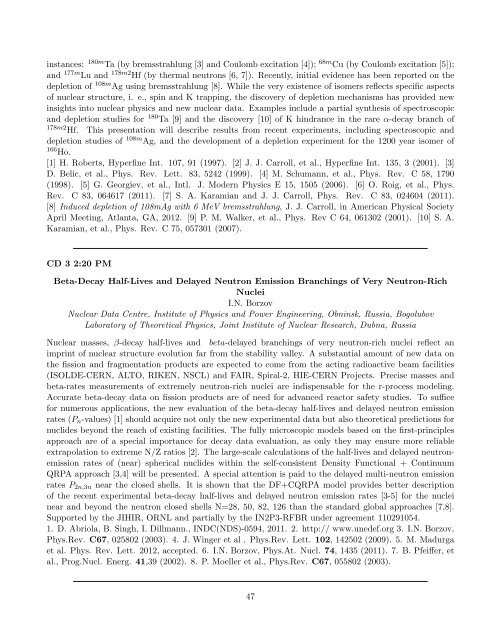Program - Brookhaven National Laboratory
Program - Brookhaven National Laboratory
Program - Brookhaven National Laboratory
You also want an ePaper? Increase the reach of your titles
YUMPU automatically turns print PDFs into web optimized ePapers that Google loves.
instances: 180m Ta (by bremsstrahlung [3] and Coulomb excitation [4]); 68m Cu (by Coulomb excitation [5]);<br />
and 177m Lu and 178m2 Hf (by thermal neutrons [6, 7]). Recently, initial evidence has been reported on the<br />
depletion of 108m Ag using bremsstrahlung [8]. While the very existence of isomers reflects specific aspects<br />
of nuclear structure, i. e., spin and K trapping, the discovery of depletion mechanisms has provided new<br />
insights into nuclear physics and new nuclear data. Examples include a partial synthesis of spectroscopic<br />
and depletion studies for 180 Ta [9] and the discovery [10] of K hindrance in the rare α-decay branch of<br />
178m2 Hf. This presentation will describe results from recent experiments, including spectroscopic and<br />
depletion studies of 108m Ag, and the development of a depletion experiment for the 1200 year isomer of<br />
166 Ho.<br />
[1] H. Roberts, Hyperfine Int. 107, 91 (1997). [2] J. J. Carroll, et al., Hyperfine Int. 135, 3 (2001). [3]<br />
D. Belic, et al., Phys. Rev. Lett. 83, 5242 (1999). [4] M. Schumann, et al., Phys. Rev. C 58, 1790<br />
(1998). [5] G. Georgiev, et al., Intl. J. Modern Physics E 15, 1505 (2006). [6] O. Roig, et al., Phys.<br />
Rev. C 83, 064617 (2011). [7] S. A. Karamian and J. J. Carroll, Phys. Rev. C 83, 024604 (2011).<br />
[8] Induced depletion of 108mAg with 6 MeV bremsstrahlung, J. J. Carroll, in American Physical Society<br />
April Meeting, Atlanta, GA, 2012. [9] P. M. Walker, et al., Phys. Rev C 64, 061302 (2001). [10] S. A.<br />
Karamian, et al., Phys. Rev. C 75, 057301 (2007).<br />
CD 3 2:20 PM<br />
Beta-Decay Half-Lives and Delayed Neutron Emission Branchings of Very Neutron-Rich<br />
Nuclei<br />
I.N. Borzov<br />
Nuclear Data Centre, Institute of Physics and Power Engineering, Obninsk, Russia, Bogolubov<br />
<strong>Laboratory</strong> of Theoretical Physics, Joint Institute of Nuclear Research, Dubna, Russia<br />
Nuclear masses, β-decay half-lives and beta-delayed branchings of very neutron-rich nuclei reflect an<br />
imprint of nuclear structure evolution far from the stability valley. A substantial amount of new data on<br />
the fission and fragmentation products are expected to come from the acting radioactive beam facilities<br />
(ISOLDE-CERN, ALTO, RIKEN, NSCL) and FAIR, Spiral-2, HIE-CERN Projects. Precise masses and<br />
beta-rates measurements of extremely neutron-rich nuclei are indispensable for the r-process modeling.<br />
Accurate beta-decay data on fission products are of need for advanced reactor safety studies. To suffice<br />
for numerous applications, the new evaluation of the beta-decay half-lives and delayed neutron emission<br />
rates (Pn-values) [1] should acquire not only the new experimental data but also theoretical predictions for<br />
nuclides beyond the reach of existing facilities. The fully microscopic models based on the first-principles<br />
approach are of a special importance for decay data evaluation, as only they may ensure more reliable<br />
extrapolation to extreme N/Z ratios [2]. The large-scale calculations of the half-lives and delayed neutronemission<br />
rates of (near) spherical nuclides within the self-consistent Density Functional + Continuum<br />
QRPA approach [3,4] will be presented. A special attention is paid to the delayed multi-neutron emission<br />
rates P2n,3n near the closed shells. It is shown that the DF+CQRPA model provides better description<br />
of the recent experimental beta-decay half-lives and delayed neutron emission rates [3-5] for the nuclei<br />
near and beyond the neutron closed shells N=28, 50, 82, 126 than the standard global approaches [7,8].<br />
Supported by the JIHIR, ORNL and partially by the IN2P3-RFBR under agreement 110291054.<br />
1. D. Abriola, B. Singh, I. Dillmann., INDC(NDS)-0594, 2011. 2. http:// www.unedef.org 3. I.N. Borzov,<br />
Phys.Rev. C67, 025802 (2003). 4. J. Winger et al . Phys.Rev. Lett. 102, 142502 (2009). 5. M. Madurga<br />
et al. Phys. Rev. Lett. 2012, accepted. 6. I.N. Borzov, Phys.At. Nucl. 74, 1435 (2011). 7. B. Pfeiffer, et<br />
al., Prog.Nucl. Energ. 41,39 (2002). 8. P. Moeller et al., Phys.Rev. C67, 055802 (2003).<br />
47
















